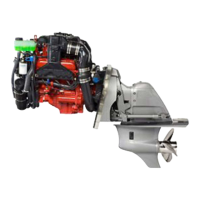Do you have a question about the Volvo Penta 4.3GS and is the answer not in the manual?
Essential safety measures for boat operation, including daily checks and hazard awareness.
Safety guidelines for engine maintenance, covering preparations, fire risks, and component safety.
Description of tachometer, temperature, oil pressure, voltmeter, and lighting switch functions.
How to use the single lever for shifting and engine speed control, including neutral.
Using control panel buttons and levers to adjust drive trim for optimal boat performance.
How the trim/tilt motor is protected from overheating by an internal thermal switch.
How the trim/tilt system provides impact protection and precautions for potential damage.
How the EFI system enters protection mode due to low oil or overheating, limiting RPM.
Safe procedures for shifting gears and controlling speed, including forward, reverse, and neutral.
How to adjust trim for starting, planing, fuel economy, choppy seas, and side winds.
How the kick-up function protects the drive when grounding and checks after impact.
Essential checks before first use and every two weeks for optimal engine performance.
Key maintenance tasks required after initial operation and at 50/100 hour intervals.
Scheduled maintenance tasks for every 200 operating hours or annually, including replacements.
General procedures for checking and adjusting engine drive belts for proper tension and condition.
Daily checks of engine oil level and procedures for topping up using recommended oil.
Step-by-step guide to draining the cooling system for 4.3, 5.0, and 5.7 models.
Instructions for inspecting and replacing seawater pump impellers for different engine models.
How the fuel pump, filter, and injection/carburetor systems work.
Critical safety precautions for handling fuel and specifications for gasoline octane and ethanol.
Step-by-step guide for replacing the fuel filter on 3.0 model engines.
Proper procedures for cleaning, gapping, and replacing spark plugs, including safety warnings.
Basic electrical system voltage, generator, fuses, and critical battery safety warnings.
Understanding causes of electrolytic corrosion and proper installation of electrical equipment.
Importance of sacrificial anodes and how to inspect and replace them for corrosion prevention.
Procedure for checking the oil level in the SX drive unit.
Step-by-step instructions for draining and refilling the SX drive unit with new oil.
Choosing propellers for optimal performance, economy, and engine RPM at full throttle.
Table listing common engine issues and their potential causes for diagnosis.
Essential safety measures for boat operation, including daily checks and hazard awareness.
Safety guidelines for engine maintenance, covering preparations, fire risks, and component safety.
Description of tachometer, temperature, oil pressure, voltmeter, and lighting switch functions.
How to use the single lever for shifting and engine speed control, including neutral.
Using control panel buttons and levers to adjust drive trim for optimal boat performance.
How the trim/tilt motor is protected from overheating by an internal thermal switch.
How the trim/tilt system provides impact protection and precautions for potential damage.
How the EFI system enters protection mode due to low oil or overheating, limiting RPM.
Safe procedures for shifting gears and controlling speed, including forward, reverse, and neutral.
How to adjust trim for starting, planing, fuel economy, choppy seas, and side winds.
How the kick-up function protects the drive when grounding and checks after impact.
Essential checks before first use and every two weeks for optimal engine performance.
Key maintenance tasks required after initial operation and at 50/100 hour intervals.
Scheduled maintenance tasks for every 200 operating hours or annually, including replacements.
General procedures for checking and adjusting engine drive belts for proper tension and condition.
Daily checks of engine oil level and procedures for topping up using recommended oil.
Step-by-step guide to draining the cooling system for 4.3, 5.0, and 5.7 models.
Instructions for inspecting and replacing seawater pump impellers for different engine models.
How the fuel pump, filter, and injection/carburetor systems work.
Critical safety precautions for handling fuel and specifications for gasoline octane and ethanol.
Step-by-step guide for replacing the fuel filter on 3.0 model engines.
Proper procedures for cleaning, gapping, and replacing spark plugs, including safety warnings.
Basic electrical system voltage, generator, fuses, and critical battery safety warnings.
Understanding causes of electrolytic corrosion and proper installation of electrical equipment.
Importance of sacrificial anodes and how to inspect and replace them for corrosion prevention.
Procedure for checking the oil level in the SX drive unit.
Step-by-step instructions for draining and refilling the SX drive unit with new oil.
Choosing propellers for optimal performance, economy, and engine RPM at full throttle.
Table listing common engine issues and their potential causes for diagnosis.
| Fuel Type | Gasoline |
|---|---|
| Configuration | V6 |
| Type | Inboard |
| Compression Ratio | 9.4:1 |
| Fuel System | Multi-Port Fuel Injection |
| Cooling System | Closed cooling system |
| Displacement | 4.3 L |
| Bore x Stroke | 88 x 88 mm |
| Max Power | 220 hp |
| Engine Type | 4-Stroke Gasoline |











